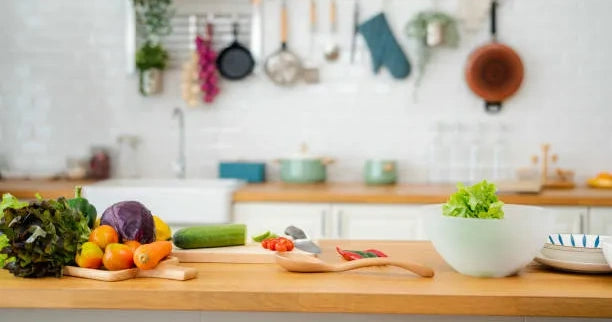
7 Common Kitchen Cooking Problems and How to Fix Them — Plus a Fun Quiz to Test Your Skills!
Share
Let’s face it, we’ve all been there: You’re in the middle of making a delicious dinner, only to encounter a kitchen conundrum that makes you question your culinary prowess. But fear not! Every cook — from beginner to seasoned pro — faces the same struggles. The good news? There’s a solution to every kitchen disaster, and I’ve got the tips to help you get through it like a kitchen superhero.
So, roll up your sleeves and get ready to laugh, because these common kitchen problems are nothing to cry over — just a little know-how and you’ll be back on track in no time!
1. Burnt Food — A Nightmare on the Stovetop
Nothing makes you cringe quite like the smell of burnt food. Whether it’s your pan-seared salmon or your stir-fry, we’ve all accidentally left something cooking just a tad too long.
The Fix:
First, don’t panic. If it’s a light burn, try rescuing the food by scraping off the burnt part and serving the rest. If you’ve turned your dinner into charcoal, it might be time to admit defeat and start fresh. For next time, invest in a timer (trust me, it’s a game-changer). And for cooking on high heat, always stay close to the stove. Remember, no one ever complained about food cooked a little slower but perfectly crisped!
2. Sticky Rice — The Great Kitchen Mystery
You know how it goes: You’re making rice, everything seems to be going smoothly, and then… BAM! It sticks together like a block of cement, and you’re left wondering where you went wrong.
The Fix:
You didn’t soak your rice! Soaking it for 20–30 minutes before cooking helps to reduce starch, which can make your rice less sticky. Also, don’t over-stir it while cooking. Stirring activates starches and can make it sticky. A little patience and the right technique will have you cooking rice like a pro every time.
3. The Dreaded Soggy Salad
Picture this: You’ve gone all out, prepared a beautiful salad with vibrant veggies, only to find that your greens have become sad and soggy the moment they meet the dressing.
The Fix:
Keep the dressing on the side until you’re ready to serve! Always add it just before eating to prevent your lettuce from wilting. Also, make sure your salad greens are completely dry before dressing. A salad spinner is your best friend here. The crispy crunch is key, after all!
4. Undercooked Chicken — The Scariest Kitchen Foe
Undercooked chicken isn’t just disappointing; it’s dangerous. If you’ve ever bitten into a piece of chicken and realized it’s still pink inside, you know the panic that sets in.
The Fix:
Invest in a meat thermometer. Chicken should reach an internal temperature of 165°F (75°C). If you don’t have one, you can cut into the thickest part of the chicken — if the juices run clear and the meat is no longer pink, you’re good to go. Also, remember to let your chicken rest after cooking to ensure the juices redistribute and you don’t lose all that moisture!
5. Lumpy Mashed Potatoes — Not Exactly What You Imagined
Everyone loves creamy mashed potatoes, but sometimes no matter how hard you mash, you end up with lumps that stick out like sore thumbs. What went wrong?
The Fix:
Start with the right kind of potato! Russets are perfect for creamy mashed potatoes. Once boiled, mash them while they’re still hot to achieve the smoothest texture. And for the ultimate creamy potatoes, warm your milk and butter before adding them in. This way, you won’t shock the potatoes with cold liquid, which could make them a bit gummy.
6. Overboiling Pasta — The Great Pasta Disaster
Ah, pasta. It seems foolproof, right? Boil it, stir it, and voilà. But sometimes, pasta can become one giant sticky clump, or worse — overcooked and mushy.
The Fix:
The secret is in the timing and the water ratio. Use a large pot with plenty of water (about 4–6 quarts for every pound of pasta). Salt the water generously, and keep it at a rolling boil. Don’t overcook it — check the package for the right cooking time, and taste-test a minute before it’s supposed to be done. When you drain your pasta, save a cup of cooking water to toss with your sauce; it’ll add some much-needed starchy goodness.
7. The Mystery of the Soggy Bottom Pie
Nothing says kitchen disappointment quite like a soggy-bottomed pie. You work hard on that golden crust, only to find it’s turned limp and soggy by the time you cut into it.
The Fix:
Blind-bake your crust! Before adding your pie filling, line your pie crust with parchment paper, fill it with pie weights or dried beans, and bake it for about 10 minutes. This pre-baking process helps set the crust and prevents sogginess. Once you’ve filled it with your delicious filling, bake as directed, and voilà — crisp, golden crust every time.
Remember, the kitchen is full of surprises, but with the right tips and tricks, you can master anything — and have fun doing it! So, keep experimenting, and don’t be afraid to laugh at your mistakes. After all, every great chef started with a few kitchen disasters of their own.
For more details, please refer to How to Cook.
